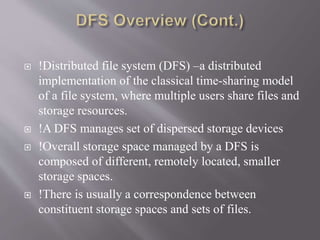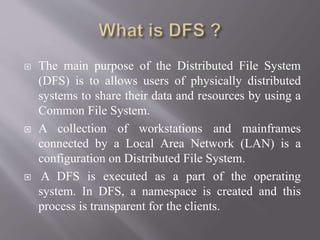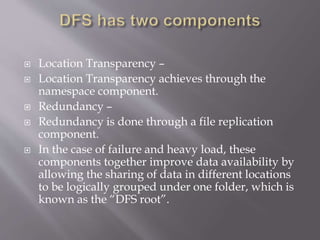DFS PPT.pptx
- 1. NADAR SARASWATHIC OLLEGE OF ARTS AND SCIENCE-THENI
- 2. !Distributed file system (DFS) –a distributed implementation of the classical time-sharing model of a file system, where multiple users share files and storage resources. !A DFS manages set of dispersed storage devices !Overall storage space managed by a DFS is composed of different, remotely located, smaller storage spaces. !There is usually a correspondence between constituent storage spaces and sets of files.
- 3. !Service–software entity running on one or more machines and providing a particular type of function to a priori unknown clients. !Server–service software running on a single machine. !Client–process that can invoke a service using a set of operations that forms its client interface. !A client interface for a file service is formed by a set of primitive file operations (create, delete, read, write). !Client interface of a DFS should be transparent, i.e., not distinguish between local and remote files.
- 4. !Introduction !DFS Issues !Naming and Transparency !Remote File Access ! Statefull versus Stateless Service !File Replication !Example Systems !AFS (vs. NFS)
- 5. A Distributed File System (DFS) as the name suggests, is a file system that is distributed on multiple file servers or multiple locations. It allows programs to access or store isolated files as they do with the local ones, allowing programmers to access files from any network or computer.
- 6. The main purpose of the Distributed File System (DFS) is to allows users of physically distributed systems to share their data and resources by using a Common File System. A collection of workstations and mainframes connected by a Local Area Network (LAN) is a configuration on Distributed File System. A DFS is executed as a part of the operating system. In DFS, a namespace is created and this process is transparent for the clients.
- 7. Location Transparency – Location Transparency achieves through the namespace component. Redundancy – Redundancy is done through a file replication component. In the case of failure and heavy load, these components together improve data availability by allowing the sharing of data in different locations to be logically grouped under one folder, which is known as the “DFS root”.
- 8. Transparency Structure transparency – Access transparency – Naming transparency – Replication transparency – User mobility Performance Simplicity High availability Scalability Data integrity Security Heterogeneity
- 9. Structure transparency –There is no need for the client to know about the number or locations of file servers and the storage devices. Multiple file servers should be provided for performance, adaptability, and dependability. Access transparency –Both local and remote files should be accessible in the same manner. The file system should be automatically located on the accessed file and send it to the client’s side. Naming transparency –There should not be any hint in the name of the file to the location of the file. Once a name is given to the file, it should not be changed during transferring from one node to another. Replication transparency –If a file is copied on multiple nodes, both the copies of the file and their locations should be hidden from one node to another.
- 10. User mobility : It will automatically bring the user’s home directory to the node where the user logs in. Performance : Performance is based on the average amount of time needed to convince the client requests. This time covers the CPU time + time taken to access secondary storage + network access time. It is advisable that the performance of the Distributed File System be similar to that of a centralized file system. Simplicity and ease of use : The user interface of a file system should be simple and the number of commands in the file should be small. High availability : A Distributed File System should be able to continue in case of any partial failures like a link failure, a node failure, or a storage drive crash. A high authentic and adaptable distributed file system should have different and independent file servers for controlling different and independent storage devices.
- 11. Scalability : Since growing the network by adding new machines or joining two networks together is routine, the distributed system will inevitably grow over time. As a result, a good distributed file system should be built to scale quickly as the number of nodes and users in the system grows. Service should not be substantially disrupted as the number of nodes and users grows. High reliability :The likelihood of data loss should be minimized as much as feasible in a suitable distributed file system. That is, because of the system’s unreliability, users should not feel forced to make backup copies of their files. Rather, a file system should create backup copies of key files that can be used if the originals are lost. Many file systems employ stable storage as a high-reliability strategy.
- 12. Data integrity :Multiple users frequently share a file system. The integrity of data saved in a shared file must be guaranteed by the file system. That is, concurrent access requests from many users who are competing for access to the same file must be correctly synchronized using a concurrency control method. Atomic transactions are a high-level concurrency management mechanism for data integrity that is frequently offered to users by a file system. Security : A distributed file system should be secure so that its users may trust that their data will be kept private. To safeguard the information contained in the file system from unwanted & unauthorized access, security mechanisms must be implemented. Heterogeneity :Heterogeneity in distributed systems is unavoidable as a result of huge scale. Users of heterogeneous distributed systems have the option of using multiple computer platforms for different purposes.
- 13. NFS – CIFS – SMB – Hadoop – NetWare –
- 14. NFS stands for Network File System. It is a client-server architecture that allows a computer user to view, store, and update files remotely. The protocol of NFS is one of the several distributed file system standards for Network- Attached Storage (NAS). CIFS stands for Common Internet File System. CIFS is an accent of SMB. That is, CIFS is an application of SIMB protocol, designed by Microsoft. SMB stands for Server Message Block. It is a protocol for sharing a file and was invented by IMB. The SMB protocol was created to allow computers to perform read and write operations on files to a remote host over a Local Area Network (LAN). The directories present in the remote host can be accessed via SMB and are called as “shares”.
- 15. Hadoop is a group of open-source software services. It gives a software framework for distributed storage and operating of big data using the MapReduce programming model. The core of Hadoop contains a storage part, known as Hadoop Distributed File System (HDFS), and an operating part which is a MapReduce programming model. NetWare is an abandon computer network operating system developed by Novell, Inc. It primarily used combined multitasking to run different services on a personal computer, using the IPX network protocol.
- 16. There are two ways in which DFS can be implemented: Standalone DFS namespace – Domain-based DFS namespace –
- 17. Standalone DFS namespace – It allows only for those DFS roots that exist on the local computer and are not using Active Directory. A Standalone DFS can only be acquired on those computers on which it is created. It does not provide any fault liberation and cannot be linked to any other DFS. Standalone DFS roots are rarely come across because of their limited advantage. Domain-based DFS namespace – It stores the configuration of DFS in Active Directory, creating the DFS namespace root accessible at <domainname><dfsroot> or <FQDN><dfsroot>
- 19. DFS allows multiple user to access or store the data. It allows the data to be share remotely. It improved the availability of file, access time, and network efficiency. Improved the capacity to change the size of the data and also improves the ability to exchange the data. Distributed File System provides transparency of data even if server or disk fails.
- 20. In Distributed File System nodes and connections needs to be secured therefore we can say that security is at stake. There is a possibility of lose of messages and data in the network while movement from one node to another. Database connection in case of Distributed File System is complicated. Also handling of the database is not easy in Distributed File System as compared to a single user system. There are chances that overloading will take place if all nodes tries to send data at once.





















